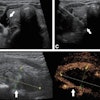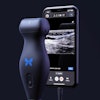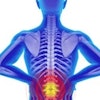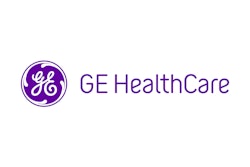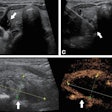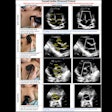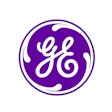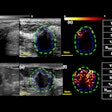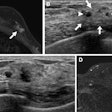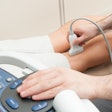A review of ultrasound performance among vascular labs has found much variation among facilities, according to a presentation at the Leading Edge in Diagnostic Ultrasound conference in Atlantic City, NJ, earlier this month.
The review was conducted by the Intersocietal Commission for the Accreditation of Vascular Laboratories (ICAVL), which randomly selected 100 ICAVL-accredited laboratories that had completed the accrediting process between January and April 2005. The facilities ranged from those completing their first accreditation to those undergoing their fifth reaccreditation application.
"Honestly, when I was all done putting (the data) together, I was somewhat disappointed in the fact that here we are, 15 years after we've accredited our first vascular lab, and we are not as standardized as I thought we would be," said ICAVL Executive Director Sandra Katanick.
Data were compiled from the selected labs' extracranial cerebrovascular, peripheral arterial, and peripheral venous testing section applications. There are currently 1,123 ICAVL-accredited vascular labs at 1,468 sites. Of these, 79% are reaccredits, while 21% are new accredits, she said.
Nineteen percent of the labs have multiple sites. The facilities have an average medical staff count of 5.7, with an average technical staff count of 4.1.
Among the accredited labs, 1,617 medical directors listed a specialty. Fifty-two percent were vascular/general surgeons, while 21% were radiologists. Cardiologists/internal medicine specialists produced 18%, with neurologists contributing 4% and other/none/shared making up 5%.
Of medical staff listing a specialty, 43% were radiologists, while vascular/general surgeons contributed 35%. Cardiologists/internal medicine specialists comprised 14%, with neurologists turning in 7% and others making up 1%.
Lab locations included 56% based in hospitals, 33% based in an office/clinic, and 5% sited in another location. Six percent were mobile setups.
Hospital-based labs were based in the radiology department in 37% of cases, and in cardiology departments in 17%. Surgery units housed labs in 10% of cases, with neurology and multispecialty vascular institutes each contributing 3%. The labs were based in other locations in 29% of cases.
In an analysis of imaging equipment by vendor from all accredited labs, 1,828 (52%) were from Philips Medical Systems, 1,065 (31%) were from Siemens Medical Solutions, and 401 (11%) were from GE Healthcare.
Biosound Esaote scanners were being used at 94 labs (3%), with Toshiba America Medical Systems scanners in place at 66 locations (2%). SonoSite systems were being utilized at 30 labs (< 1%), Katanick said.
Carotid duplex
In its accreditation application, ICAVL queries labs about the specific criteria they use to assess the degree of stenosis of the internal carotid artery (ICA).
Ninety-five percent of the sample labs said they used peak systolic velocity (PSV), and 91% used ICA end-diastolic velocity (EDV). Seventy-nine percent used ICA/common carotid artery (CCA) systolic ratio, 52% employed CCA PSV, 35% utilized CCA EDV, and 18% used ICA/CCA end diastolic ratios. Three labs did not check any answers.
Twenty-four percent used vertebral PSV, while 5% used vertebral EDV. Fifty-four percent used color Doppler changes, 24% used image measurements, 68% used plaque characterization, and 1% used other ratios, she said.
The ICAVL also asked each lab about what specific ranges of ICA stenosis they used (i.e., normal, 1% to 15%, etc.). The vast majority of the labs (65) in the sample population used six categories, Katanick said. Four labs had four categories, 18 labs used five categories, and 11 sites used seven categories.
For the first range, 67 labs used normal, although there were actually 13 different range 1 values among the labs, she said. There were 25 different range 2 values among the sample labs, the most popular of which was 1% to 15% (29 labs).
Twenty ranges were listed for category 3 values, with 16% to 49% leading the way (29 labs). For carotid stenosis category 4 values, 17 different ranges were used, with 50% to 79% (26 labs) the most popular. In category 5 values, 80% to 99% (54 labs) was the most frequently used range.
Occluded was the value most commonly used for category 6 (62 labs). For those 12 labs using seven categories, occluded was the most common category 7 range (11 labs). Two labs used an eighth category: one used a range of 75% to 80% and the other used occluded.
ICAVL also asked labs to identify the primary reference studies they used for QA comparisons. Contrast angiography was utilized by 86 labs, MR angiography by 54, surgical correlation by 39, pathologic specimen correlation by seven labs, and seven labs used other reference studies.
Labs using contrast angiography for their correlation reported an 82% average percent accurate rate, while MR carotid correlation yielded a 79% accuracy rate.
Arterial duplex
For their predominant arterial testing modality, 52% of the sample vascular labs used pressure measurements and waveforms. Duplex with pressure measurements were used in 16% of cases, with 10% using a combination of both methods.
As for duplex parameters used in arterial duplex evaluation, 62% employed peak systolic velocities, and 17% used end diastolic velocities. Thirty-one percent utilized systolic ratio, 15% used image measurements, and 39% used color Doppler changes. None use diastolic ratios anymore, Katanick said.
Twenty-eight labs used six diagnostic categories, while 26 used five. Sixteen sites employed four categories, while three used three categories and four used two.
Normal was the first arterial duplex category used in 66 labs. There were 17 different ranges listed for arterial duplex categories, with 1% to 15% the most popular (20 labs). Eleven ranges were listed for category 3, with 50% to 79% (20 labs) used the most.
For the fourth category, 11 ranges were also listed with 50% to 79% (20 labs) again being the most commonly used. Occluded was the most commonly used fifth category with 22 labs.
Contrast angiography was the primary reference study for QA arterial comparisons in 76 of labs, with MR angiography used by 17. Surgical correlation was used by 13, with pathology specimen correlation used by two and one lab listed "other" for its primary reference study.
Labs using contrast angiography for arterial correlation labs had an 84% accuracy rate for locating the disease. For contrast angiography correlation for severity, labs had an average accurate rate of 88%. For MR arterial severity correlation, the labs had an average percent accuracy of 79%.
Venous testing
Of the lower-extremity veins examined, 2% of labs said they examined the IVC, 11% said they examined the common iliac, and 9% examined the external iliac. Ninety-nine percent said they examined the common femoral, and 100% examined the femoral.
Fifty-seven percent examined the profunda, 100% examined the popliteal, and 90% examined the posterior tibial vein. Twenty-six percent examined the anterior tibial, 62% examined the peroneal, and 86% examined the saphenous. Other veins were cited by 9%, Katanick said.
Of the upper-extremity veins examined, 97% used the internal jugular, 99% used the subclavian, 96% used the axillary, 97% used the brachial, and 82% used the basilic. Sixty-one percent used the cephalic, 50% used the radial, 50% used the ulnar, and 4% used another vein, Katanick said.
Of the techniques used in venous evaluation, 100% of the labs perform transverse compression, 96% utilized direct visualization, and 93% employed color-flow Doppler, Katanick said. Three percent perform longitudinal compression, 63% do insufficiency testing, and 95% perform spectral Doppler studies.
For venous QA, clinical outcome was used by 65%, with 32% having some type of correlation with venography, Katanick said.
The data show that numerous sets of diagnostic criteria as well as techniques are used by vascular labs, Katanick concluded. Most labs use a combination of measurements and techniques to arrive at a final diagnosis, and multiple methods for correlation exist and are used, she said.
"We still have a lot of room for standardization," she said.
By Erik L. Ridley
AuntMinnie.com staff writer
May 23, 2005
Related Reading
Vascular labs on the rise in echo cath labs, June 16, 2004
Pitfalls abound in venous ultrasound, May 13, 2004
Non-radiologists outpace radiologists in skyrocketing use of ultrasound, December 1, 2003
Controversy flows freely in venous ultrasound, August 28, 2003
Ultrasound on the rise, may yield cost savings, January 31, 2003
Copyright © 2005 AuntMinnie.com

